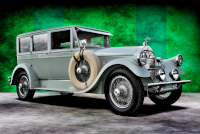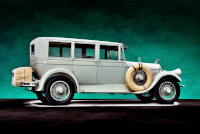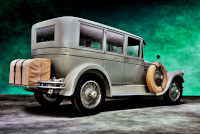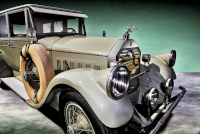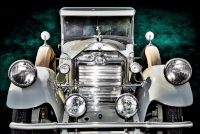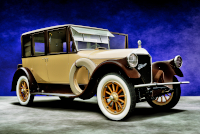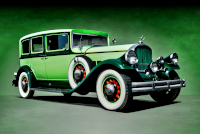Location:
Radnor Hunt Concours d'Elegance, 2023
Radnor Hunt Concours d'Elegance, 2017
Owner: Antique Automobile Club of America (AACA) Museum | Hershey, Pennsylvania
Prologue:
We first spotted this Model 36 Sedan at Hershey in 2012, which led to a couple snaps for posterity it seems. A second encounter in 2017 brought the high-resolution images you see here. And in the wake of development I can't bring myself to revive the old stock, though I had long ago published a front-quarter perspective from that Hershey show. These illustrations are right, I think. As to the car, I appreciate the story of its previous owner and restorer, Ron Blissit of Norman, Oklahoma, who made good on a 38-year-old whim. The Blissits donated the car to the AACA Museum, and so its sightings have become a local Pennsylvanian commodity.
Recently added, a single portrait from the wet and drippy 2023 Radnor Hunt Concours d'Elegance shows off three interesting pieces of Pierce-Arrow iconography—the early Art Deco version of the archer mascot, the company seal, and the embossed Pierce-Arrow coachwork illustration. Likely we'll see this sedan on occasion and perhaps add to our set, though the head end is worth a close look to begin.
- - - - - - - - - -
► Image Source: Nikon D750 (24.3 MP)
References:
- Ralston, Marc. "Pierce-Arrow" A.S. Barnes & Co., Inc., San Diego, CA. 1980, page 120-121, 232
- Automobile Quarterly, Volume 6, Number 3, Third Quarter 1968, "Pierce-Arrow: An American Aristocrat" by Maurice D. Hendry, The Kutztown Publishing Company, Inc., Kutztown, PA, page 257
- The Oklahoman: "Car Inspires Dream 1928 Pierce-Arrow Restoration Complete," by Greg Kennedy, January 27, 1999
- Old Cars Weekly: A nice article on Al Ferrara's 1928 Model 36 Sedan. All model information in the story reproduces Marc Ralston's 1980 history.
We know this Pierce-Arrow Model 36 as the Paramount Studios car used to chauffeur Marlene Dietrich to work, though her 1930 Rolls-Royce Phantom I is a much better documented cabbie. The Pierce-Arrow resides in the Antique Automobile Club of America (AACA) Museum in Hershey, Pennsylvania. But the story of its preservative dates back to Oklahoma, 1957, when Ron Blissit and his father first encountered the car, heard about its connection to the actress, and considered what a nice restoration project it would be.
38 years later, in which time he honed his restoration skill, Blissit happened across the car at a swap meet. The Oklahoman reports, "Blissit talked with his wife, Jody, and they agreed to trade her 1972 Mercedes, which he had restored, for the Pierce Arrow." The Blissits restored the Model 36 in three years, toured the car at major events around the country, and later donated the car to the AACA museum in honor of Ron's father, who had been a Pierce-Arrow dealer.
Pierce-Arrow's Insufficient Stop-Gap
History regards the Model 36 rather for what it is not, more than what it is. (Even in the moment, the Model 36 represented what little remained of Pierce-Arrow's golden years—what they had refused to change for so long.) Ralston notes that, in 1926, Pierce-Arrow "brought out just what the public didn't need—the Series 36," a high-end six-cylinder successor to the Models 33, 32, and 31, dating back to the Dual Valve debut in 1919. Pierce-Arrow had postponed an upgrade to eight cylinders for far too long, and lacquered wood and fine silk could not convince buyers at the very top of the automotive market otherwise.
1928 is the break point. Much of the executive leadership that carried Pierce-Arrow through the 1920s die within a few years of one another, and the company agrees to a Studebaker merger. The sale is of course a long-planned inevitability; the sequential deaths of engineers Charles Sheppy and John Talcott, and long-term executives Colonel Charles Glidden, Colonel Charles Clifton, and Myron Forbes merely underscore the steadiness of Pierce-Arrow's march toward the brink. Staunch in its beliefs, the company rode the tide of previous innovations, and no longer sought progress of the same degree. To be fair, Pierce-Arrow no longer profited enough to try, well beyond its cost-no-object days of experimental development. So, by its technological merits, in 1928 Pierce-Arrow produced a less inspired motor car than that of the late teens.
So what is noteworthy about the Model 36, and in particular the 1928 Model 36, is that it is the very last of the Pierce-Arrow big sixes, equipped with the last iteration of the Dual Valve (four valves per cylinder) T-head block. Built with aluminum alloy through the crank case, rods, pistons, and housings, and clothed in an aluminum-panel body, the Model 36 is the last artefact of the plan Pierce-Arrow was convinced would endure. The company espoused a sense of adequacy: What could be built to Pierce-Arrow spec and perform according to Pierce-Arrow expectations would be inherently better than the rest of the market. Durability—whether of independent materials or the whole package as conceived, tested, and delivered—was in their estimation the most valuable mark of a luxury good. By 1928 the public thought otherwise, ascribing more significance to style and multi-cylinder power than Pierce-Arrow were prepared to accept.
About a year in the future, Studebaker's purchase will inject $2,000,000 into Pierce-Arrow. Even better, mutual respect between corporations will provide amicable working conditions and keep strategic control in Buffalo. These funds allow Pierce-Arrow to at long last pivot and get after market share lost to Cadillac and Packard. But the partnership will stand only until 1933, when Studebaker will sell Pierce-Arrow for half of its purchase price.
Motor: 6,796 cc (marketed as 415 cubic inches, actual 414.7) Dual-Valve inline 6-cylinder | 101.6 mm x 139.7 mm (4" x 5½")
A single cast "en bloc" with removable head, as for its Model 33 predecessor, the 1928 Model 36 is the final 6-cylinder Pierce-Arrow, ending a 21-year run.
Valvetrain: T-head, 4 valves per cylinder, twin-plug ignition via Delco dual distributor with two plugs per cylinder
Aspiration: single Stromberg carburetor
Power: 100 hp @ 3,000 rpm
The National Automobile Chamber of Commerce (NACC) rating is 38.4 hp.
Drivetrain: 3-speed manual transmission, rear-wheel drive
Front Suspension: solid axle with semi-elliptic leaf springs and Houdaille shock absorbers
Rear Suspension: live axle with semi-elliptic leaf springs and Houdaille shock absorbers
Architecture: steel frame, aluminum sheet body panels over white ash frame
Wheelbase: 3,505.2 mm (138 inches)
Top Speed: 115.8 km/h (72 mph)
Etymology:
Successor to the Model 33, the roots of the Model 36 trace back to 1919's Model 31. Though each model update received a sequential model number, the debut of the Model 36 in 1926 skipped a couple places. The reason for the model number bump may suggest a feeling of lethargy endured since the Model 31, punctuated by four years of the Model 33 from 1922 to 1925. Or Pierce-Arrow may have liked the chance to reference the old Model 36 from the company's halcyon days, (though the new Model 36 is not so much related). Or Pierce-Arrow simply liked the symmetry of debuting the Model 36 in 1926. Whatever the case, the Model 36 is the last of the great Pierce-Arrow sixes.
Figures:
Without reliable records, Ralston supposes Pierce-Arrow produced approximately 500 Model 36 cars in 1928, and that total production from 1927 to 1928 resulted in 1,900 to 2,000 cars. So many decades ago (1980), the Pierce-Arrow Society registered 30 examples, which suggests a survival rate of 1.5%
Value:
In a welcome breath of fresh air, The Oklahoman reports that owner and restorer Ron Blisset restored and cared for the car out of pure interest, perhaps even as a mark of long unfinished business. "As for total worth of the car, Blissit said he'll never really know. He never kept track of how much money he put in the project because he did not want to discourage himself from completing it. And he'll never sell the car. 'I'd rather give the car to the Pierce Arrow Museum,' Blissit said. 'I'll never really know what it's worth.'" The Blissets donated the car to the AACA Museum.
Slightly Modern: Late Antique Characteristics with Simple Updates
By 1928, very little changes in the sedan approach, namely the enclosed-drive compartment with triangular quarter-lights. The pattern fits that of Pierce-Arrow sedans dating back to the Model 32 of 1921.
From the early 1920s to the late 1920s, we see the aspect of the chassis and running gear visually lengthened, though the wheelbase remains the same. Part of the effect stems from more modern six-ply tyres and wire wheels, as opposed to the thin tyres and artillery wheels of the antique period. Of course, Pierce-Arrow will persist with artillery wheels into the 1930s, (again, believing in the prestige of fine materials), but we at least see an early sign that Pierce-Arrow might finally accept the modern automobile idea.
First Archer: Pierce-Arrow's Original Art Deco Archer Mascot
While 1928 is the break point for Pierce-Arrow, and Studebaker an amicable partner, this is the first year for the archer mascot. The original 1928 design sets down the concept that Pierce-Arrow will become known for in the classic era, though it is rudimentary. The early archer wears a helmet and lacks the energy and physique of the 1930 refurbishment. Nevertheless, we see here for the first time the classic combination of integrated headlamps and archer, the two most easily recognizable Pierce-Arrow attributes.
Fancy Fascia: The Pierce-Arrow Winterfront Grille
Various sources note that Pierce-Arrow applied a crest to the 1928 Model 36 radiator, whereas on 1926-27 models the radiator is bare. The crest contains the company motto, Dixit et Fecit, perhaps best translated in shorthand as, "said and done." More prominent is the Pierce-Arrow Winterfront slatted grille fitted to this car, behind which sits the "Pierce" script seen among some antique Pierce-Arrow cars. The insignia on the shroud includes a fine hexagonal relief of a Pierce-Arrow nose in perspective, showcasing the integrated Dawley headlamps, an illustration seen on period coachwork badges applied by the factory, as well as ornamental castings earlier in the decade. This Model 36 also wears two additional light sets, a pair of Pierce-branded lamps above the front guard, and a smaller set on a light bar. Our 2012 photos show the shroud in its open position, though I am disinclined to pursue its depiction due to the disparity between those older photographs and these.
Interior Appointment: Pierce-Arrow Model 36 Cabin Features
While Pierce-Arrow styling development froze for much of the 1920s, the company's confidence in material quality as a measure of luxury persisted. In the cabin, Pierce-Arrow fitted Wilton velvet carpet, English upholstery, and silk blinds. All of the interior hardware is gold-plated and the dash display fashioned of inlaid wood. The dash in particular is far more elaborate than automobiles produced at the height of Pierce-Arrow notoriety, as at the time the driver's compartment would have been viewed through a utilitarian lens. And in the moment, doubling down on fine materials is as much as Pierce-Arrow can do to sustain its luxury reputation, seeing that build quality no longer carries much cachet.
Last Updated: Mar 26, 2025

